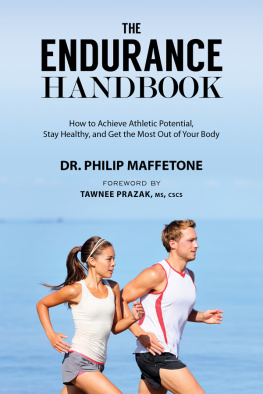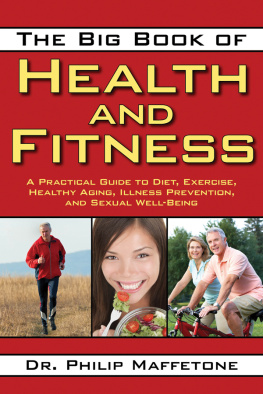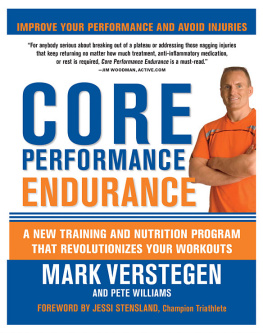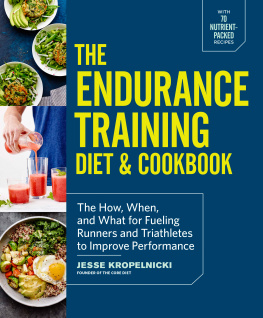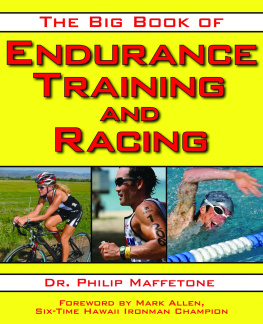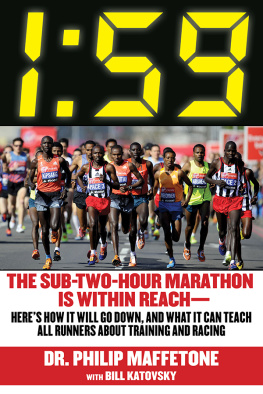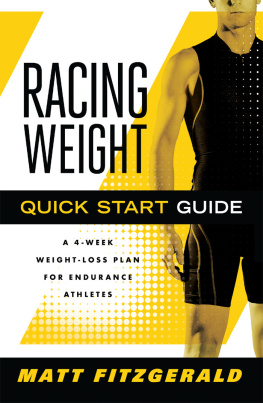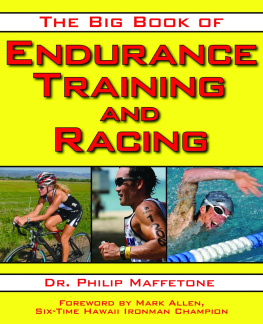Copyright 2015 by Dr. Philip Maffetone
Foreword copyright 2015 by Tawnee Prazak
All rights reserved. No part of this book may be reproduced in any manner without the express written consent of the publisher, except in the case of brief excerpts in critical reviews or articles. All inquiries should be addressed to Skyhorse Publishing, 307 West 36th Street, 11th Floor, New York, NY 10018.
Skyhorse Publishing books may be purchased in bulk at special discounts for sales promotion, corporate gifts, fund-raising, or educational purposes. Special editions can also be created to specifications. For details, contact the Special Sales Department, Skyhorse Publishing, 307 West 36th Street, 11th Floor, New York, NY 10018 or .
Skyhorse and Skyhorse Publishing are registered trademarks of Skyhorse Publishing, Inc., a Delaware corporation.
Visit our website at www.skyhorsepublishing.com.
10 9 8 7 6 5 4 3 2 1
Library of Congress Cataloging-in-Publication Data is available on file.
Cover design by Qualcom Designs
Cover photos: Thinkstock
Print ISBN: 978-1-63220-498-1
Ebook ISBN: 978-1-63220-867-5
Printed in the United States of America
CONTENTS
FOREWORD
I first found out about Dr. Phil Maffetone and the Maffetone Method through my podcast, Endurance Planet, in which my co-hosta coach and former professional triathlete himselfintroduced me to Phils aerobic-based heart-rate training. The concept, while nothing new in 2012, resonated with our podcast fans and more so it resonated with me. I read everything I could on the Maffetone Method to become an expert. Meanwhile, fans of our podcast began submitting dozens of questions asking everything you can imagine about the Maffetone Method, or MAF as its commonly called for short (in fact, MAF stands for Max Aerobic Function and is not just Maffetones name abbreviated). That year its as if MAF had a rebirth on Endurance Planet, helping a whole new generation of endurance athletes understand how to reach new levels of performance and health (complete with the standard frustrations of athletes having to run slow to get fast). To this day, we address MAF so frequently on Endurance Planet that its often accompanied with a laughyup, another MAF questionand it makes sense as to why: Everyone wants help on figuring out their unique path with the MAF approach because its not a one-size-fits-all approach.
I eventually reached out to Phil asking him to be a guest on the podcast, and upon our first meeting and podcast recordingvia Skype videowe quickly bonded and a friendship evolved. We continued podcasting together, and our chats would always run much longer than what was actually recorded for the show.
I am also an endurance coach and triathlete, and getting to know Phil and his work was greatly influential in molding my style of coaching as well as making me the athlete I wished to be. I was captivated by Phils ability to listen, observe and assess peoplemyself included! (Its like he knows me better than me at times!) His wisdom and depth of knowledge are so vast, yet his presence is laid-back and casual. As a clinician whos so dedicated to collecting data and taking objective measurements, hes equally a free spirit and has a tendency to go off the grid to do his thingsomething we should all mimic in effort to let go of being a chronically connected, go-go-go society. Phils lifestyle is a testament that hes practicing what he preacheshe lives with low stress, he eats incredibly well even gathering food from his own garden, he moves and exercises in a way that keeps him strong and intact, and he has talents and hobbies that expand way beyond sport including his musical prowess.
While my coaching career does not span as many decades as Phils does (but it will!), I am deeply ingrained in the endurance sports world, and its clear to me we need more coaches and athletes to consider (and hopefully adopt) Phils principles in their practices and lives. All too often I observe athleteswhether pro or amateurwrecking their bodies in search of some extreme level of performance (usually, theres a coach somewhere supporting it), and at first it seems promising with some decent results, but eventually those athletes are unable to reach or hold on to those extremes because the body gives out in some form: injury, hormonal disruption, or some combination or manifestation that ultimately leads to a decrease in performance. This is an important concept youll hear Phil discuss in this book.
To be perfectly honest, Ive been there. As an athlete, I have made the mistake of doing more volume and intensity than what was healthy for my body. I eventually realized this, and even when I scaled back to MAF-based training I still found myself deeply evaluating my lifestyle and stress levels in order to fully recover and become healthy and stronger again.
And thats the thing about the Maffetone Method: Its all connected. Its all related. Athletic performance, health and lifestylethey are all intertwined. With MAF, you cant hide behind poor health, and you cant hide behind bad habits. If you try, this method will wave its big fat red flags at you, namely the inability to improve at your MAF heart rate. In fact, the Number One reason people get frustrated and give up on MAF is that theyre not able to go faster at the MAF heart rate. But its not because MAF was wrong for them; its because they didnt look deeper to solve underlying lifestyle problems that were causing this block.
Additionally, athletes and coaches will often argue that more intensity is needed than whats offered in the Maffetone Method. As such, many training programs and coaches dish it out under the notion that in order to perform better and/or to be the best you must train harder, longer, take minimal recovery until youre back at it... and your health? Worry about that at some other time in life, they say, because sacrificing health now is OK; its what it takes to get better. Right? Wrong. Sadly, many athletes (and coaches) choose performance at the cost of health. Were constantly taught to adopt a mindset of no pain, no gain and go until you crash.
But it doesnt have to be this way to be successful.
If your body is in sync and in tune, then the Maffetone Method is a beautiful thingjust look at the success of six-time Ironman World Champion Mark Allen or my podcast co-host, Tim Luchinske, who was a talented professional triathlete-turned-ultrarunner, whos been top-10 in the Ironman World Championships, and in 2012 was overall winner of the grueling Leadman Ultra Seriesno easy feat.
The Maffetone Method is the only training system I know of that promotes optimal performance and health, while remaining incredibly individual. When I coach athletes with the Maffetone Method it leads us to discovering more about that person as a whole, and we can collaborate to find their unique path to success. It forces you to evaluate your life, your health, your relationships, and so on, and sometimes the answers arent clearsometimes theyre surface aspects of your existence that are tough to face and commit to changing, but you know you need just that. In that sense, its not an easy training program to follow despite a simple formula of 180 minus your age, and thats the target heart rate at which to train. The Maffetone Method is not like a Jack Daniels or Joe Friel program for runners or triathletes, respectively, in which you can literally cut and paste the workouts into your schedule. Phil himself says plenty of times hes not here to simply give you a weekly schedule to follow.

